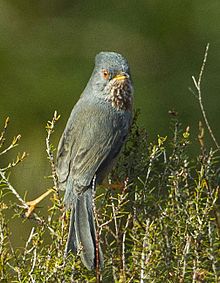Old World warblers are a large group of birds formerly grouped together in the bird family Sylviidae. They are not closely related to the New World warblers. The family held over 400 species in over 70 genera, and were the source of much taxonomic confusion. Two families were split out initially, the cisticolas into Cisticolidae and the kinglets into Regulidae. In the past ten years they have been the subject of much research and many species are now placed into other families, including the Acrocephalidae, Cettiidae, Phylloscopidae, and Megaluridae. In addition some species have been moved into existing families or have not yet had their placement fully resolved. A smaller number of warblers, together with some babblers formerly placed in the family Timaliidae and the parrotbills, are retained in a much smaller family Sylviidae.

The garden warbler is a common and widespread small bird that breeds in most of Europe and in the Palearctic to western Siberia. It is a plain, long-winged and long-tailed typical warbler with brown upperparts and dull white underparts; the sexes are similar and juveniles resemble the adults. Its two subspecies differ only slightly and interbreed where their ranges overlap. Due to its lack of distinguishing features, this species can be confused with a number of other unstreaked warblers. The garden warbler's rich melodic song is similar to that of the blackcap, its closest relative, which competes with it for territory when nesting in the same woodland.

The barred warbler is a typical warbler which breeds across temperate regions of central and eastern Europe and western and central Asia. This passerine bird is strongly migratory, and winters in tropical eastern Africa.

The common whitethroat or greater whitethroat is a common and widespread typical warbler which breeds throughout Europe and across much of temperate western Asia. This small passerine bird is strongly migratory, and winters in tropical Africa, Arabia, and Pakistan.
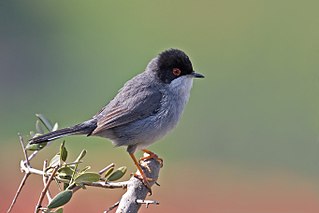
The Sardinian warbler is a common and widespread typical warbler from the Mediterranean region. Like most Curruca species, it has distinct male and female plumages. The adult male has a grey back, whitish underparts, black head, white throat and red eyes. Plumages are somewhat variable even in the same locality, with the intensity of a reddish hue on upper- and/or underside that varies from absent to pronounced. The female is mainly brown above and buff below, with a grey head. The Sardinian warbler's song is fast and rattling, and is very characteristic of the Mediterranean areas where this bird breeds.

The western subalpine warbler is a small typical warbler which breeds in the southernmost areas of Europe and north-western Africa.

The Cyprus warbler is a typical warbler which breeds only on Cyprus. This small passerine bird is a short-distance migrant, and winters in Israel, Jordan and Egypt.

The lesser whitethroat is a common and widespread typical warbler which breeds in temperate Europe, except the southwest, and in the western and central Palearctic. This small passerine bird is strongly migratory, wintering in Africa just south of the Sahara, Arabia and India.
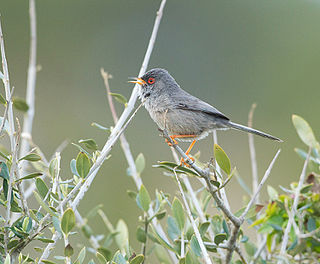
Balearic warbler is a typical warbler, genus Curruca. It is endemic to the Balearic Islands, apart from Menorca. It groups with the Marmora's warbler, Tristram's warbler and the Dartford warbler.

The common grasshopper warbler is a species of Old World warbler in the grass warbler genus Locustella. It breeds across much of temperate Europe and the western Palearctic. It is migratory, wintering in north and west Africa.

The African desert warbler is a typical warbler.
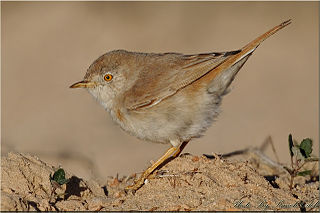
The Asian desert warbler is a typical warbler which breeds in the deserts of central and western Asia and the extreme east of Europe, and migrating to similar habitats in southwestern Asia and the far northeast of Africa in winter. Until recently it was considered conspecific with the African desert warbler, but is now given specific status. The two are still each other's closest living relatives, and their relationships to other typical warblers are not clear. They may be fairly close to the common whitethroat; particularly, female whitethroats look much like a richly coloured Asian desert warbler. But it seems that all these three taxa are fairly basal members of the genus.

Rüppell's warbler is a typical warbler of the genus Curruca. It breeds in Greece, Turkey and neighbouring islands. It is migratory, wintering in northeast Africa. This is a rare vagrant to western Europe. The name is occasionally cited as "Rueppell's warbler".
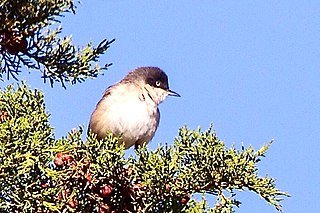
The western Orphean warbler is a typical warbler of the genus Curruca. This species occurs in summer around the Mediterranean, through western Europe and extending into northwest Africa. It is migratory, wintering in Sub-Saharan Africa. It is a rare vagrant to northern and north-western Europe.

Marmora's warbler is a typical warbler in the Sylviidae family. The specific sarda is a Latin feminine form for a person from Sardinia.

The spectacled warbler is a species in the typical warbler genus, Curruca. The specific conspicillata is from Latin conspicillum, a place to look from, equivalent to "spectacled".
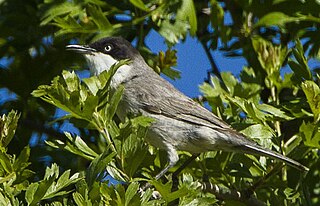
The eastern Orphean warbler is a typical warbler of the genus Curruca. This species occurs in summer around the Mediterranean, through the Balkans via Turkey, the Caucasus and surrounding regions to Central Asia. It is migratory, wintering in sub-Saharan Africa.
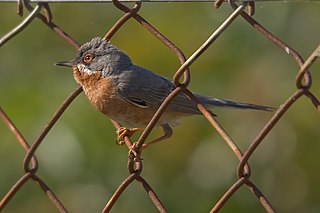
The eastern subalpine warbler is a small typical warbler which breeds in the southernmost areas of Europe. It was first described by the German naturalist Peter Simon Pallas in 1764 and given the binomial name Motacilla cantillans. The specific cantillans is Latin for "warbling" from canere, "to sing".

Menetries's warbler or Ménétries's warbler is a small passerine bird of Southwest Asia belonging to the genus Curruca. The name of the species commemorates Édouard Ménétries, the French zoologist who described the species in 1832. It is closely related to the Sardinian warbler of the Mediterranean basin and is similar to it in appearance.

The Arabian warbler, also known as Red Sea warbler or Blandford's warbler, is a species of Old World warbler in the family Sylviidae. It is found in Djibouti, Egypt, Eritrea, Israel, Jordan, Oman, Saudi Arabia, Somalia, Sudan, and Yemen. Its natural habitat is dry savanna country where it is often found in patches of Acacia.
